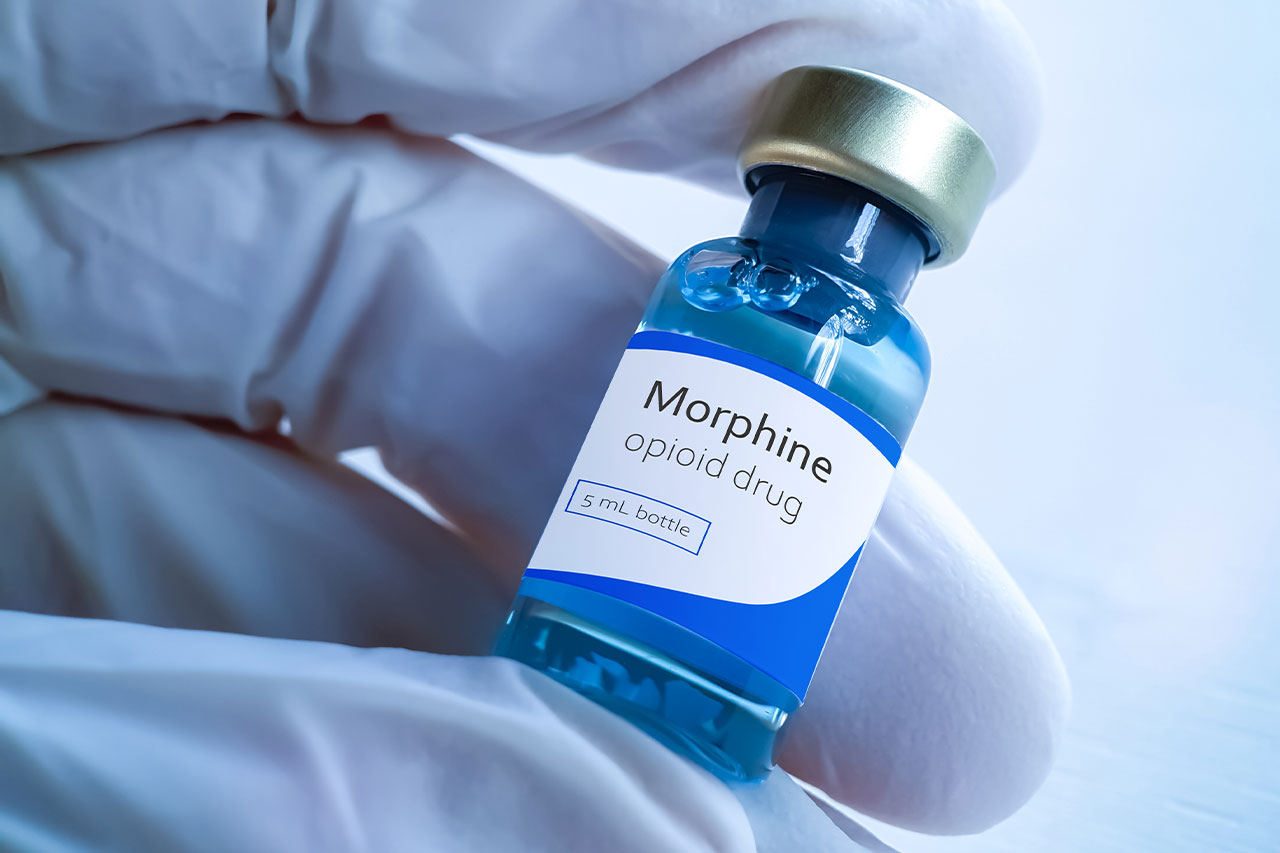Choosing the best form of pain management is crucial for achieving comfort and improving one’s quality of life. Opioids like Dilaudid and morphine are some of the most commonly prescribed painkillers to this day. However, they also present a variety of dangers, including the potential for abuse and addiction. For these reasons, it’s crucial for individuals interested in taking these medications for pain relief to understand their benefits and drawbacks. To aid individuals in making informed decisions and avoiding risks like addiction, our luxury drug and alcohol rehab in South Florida is sharing a guide on Dilaudid vs Morphine.
Is Dilaudid Morphine?
No, Dilaudid is not morphine. Rather, it’s the brand name for the opioid hydromorphone. While both Dilaudid and morphine are strong opioids used for treating pain, they’re distinct drugs with different levels of potency, onset of action, duration, and potential side effects.
More specifically, Dilaudid is a semi-synthetic opioid that’s derived from morphine. It’s known for its high potency and effectiveness in reducing severe pain. Due to these factors, Dilaudid is often administered in smaller doses than morphine to achieve the same effect.
Dilaudid is usually a last resort medication that doctors may prescribe to patients who have severe pain but are tolerant to or haven’t experienced relief from other opioids. It’s usually injected under the skin or into a muscle or given as an infusion into a vein by the prescribing doctor. However, it does come in tablet form and is usually only administered as an injection if the person cannot take the medication orally.
Common side effects of Dilaudid include:
- Headache
- Sedation
- Dizziness
- Difficulty falling asleep or staying asleep
- Dry mouth
- Lightheadedness
- Excessive sweating
- Muscle, back, or joint pain
- Abdominal pain
- Anxiety or nervousness
- Flushed or red skin
- Itching and/or rash
- Depressed mood
As an opioid, Dilaudid has a high potential for abuse and addiction. Patients who have taken it for a while or have become dependent on it and attempt to stop taking it without medical care may experience serious withdrawals. If you need help stopping an opioid medication, our facility offers medically-monitored opioid detox that can help you or a loved one recover safely.
What Is Morphine?
So, if Dilaudid isn’t morphine, then what is it? Otherwise referred to by brand names like MorphaBond ER, Arymo ER, and Astramorph-PF, morphine is an opioid analgesic that’s also used to treat pain. It’s usually administered into a vein or muscle, and injections are typically administered once every 4 hours as needed.
Morphine may also come in extended-release tablets, which are taken orally. Like Dilaudid, morphine is normally only prescribed to patients who have become tolerant to other opioid medications and haven’t experienced relief while using them.
Common morphine side effects include:
- Sedation
- Dizziness
- Drowsiness
- Cramps
- Abdominal pain
- False or unusual sense of well-being (euphoria)
- A relaxed or calm feeling
- Change in vision
- Dry mouth
- Heartburn
- Decreased libido or sex drive
- Irregular or stopped menstrual cycles
When considering morphine versus Dilaudid for pain management, keep in mind that long-term morphine use or abuse may also present risks like physical dependence and addiction. If you’re taking this medication and find yourself needing higher doses to experience the same relief, reach out to a professional facility like our prescription drug rehab to create a safe treatment plan for recovery.
Is Dilaudid Stronger Than Morphine?
When comparing morphine vs hydromorphone, people also wonder which one is stronger or better for pain. However, Dilaudid is stronger than morphine 10 times stronger, to be exact. For this reason, Dilaudid is often used in cases of severe pain, such as post-surgical pain or pain caused by certain medical conditions.
Even so, its potency also means that it should be used with caution and under the direction of a healthcare professional to minimize the risk of side effects and dependence. Whether Dilaudid or morphine is prescribed depends on the severity of the individual’s condition among other factors.
For instance, Dilaudid and morphine dosing may depend on whether they’re immediate or extended-release. Immediate-release drugs kick in within 30 minutes and are usually taken every four to six hours, while extended-release drugs are slowly released in the body over an hour or so and taken less often throughout the day.
Ultimately, if we’re to compare the dosing of Dilaudid and morphine, you would need a smaller dose of Dilaudid to experience the same effects as a higher dose of morphine. For instance, a person who takes 10 milligrams (mg) of morphine may only have to take 1 to 2 mg of Dilaudid. Again, what and how much the individual is prescribed depends on their condition.
Hydromorphone vs Morphine: What’s the Difference?
So, what is the difference between Dilaudid and morphine? Differentiating between the two can be hard, considering how similar they are. For instance, they’re both opioid analgesics, they both produce sedation, and they both treat pain, but they aren’t the same medication.
The difference between hydromorphone and morphine is that hydromorphone is more potent than morphine, meaning smaller quantities are needed to produce the same relief. In comparing Dilaudid vs morphine, you’ll also find the differences below:
- Potency: As we previously mentioned, Dilaudid is more potent than morphine, meaning that a smaller dose of Dilaudid is usually needed the morphine to alleviate pain.
- The onset of action: Dilaudid usually kicks in faster than morphine.
- Duration of effects: Morphine generally lasts longer than Dilaudid.
- Methods of administration: Both Dilaudid and morphine can be administered in various ways, including oral, intravenous (IV), intramuscular (IM), and subcutaneous (under the skin) injections. However, unlike morphine, Dilaudid can also be administered through intranasal, intravenous, and sublingual (under the tongue) routes.
- Side effects: While both medications produce common opioid side effects like constipation, nausea, vomiting, drowsiness, and the potential for respiratory depression (slowed breathing), the strength and frequency of these effects may vary between morphine and Dilaudid due to their differences in potency.
- Medical use: As we previously mentioned, Dilaudid is usually used in more severe cases, such as post-surgical pain, cancer pain, and pain associated with certain medical conditions. Although morphine is also used for treating pain but is more commonly used to treat moderate to severe pain.
- Conversion and equivalence: Healthcare providers need to be especially careful when calculating the conversion from Dilaudid to morphine. Converting between the two requires expertise regarding their appropriate dosage adjustments and applications.
- Individual response: An individual’s responses to either medication can vary based on factors like tolerance, metabolism, and overall health. Therefore, it’s normal for some patients to find one medication more effective than the other.
The choice between morphine or Dilaudid should be made with the direction of your healthcare provider. Do not attempt to obtain or take any medication without the direction of a prescribing doctor. Additionally, be sure to speak to your doctor about any medication risks like dependence, as opioids like Dilaudid and morphine are addictive.
Dilaudid Vs Morphine: Their Similarities
Other than that, the two are quite similar. Both Dilaudid and morphine alleviate pain by binding to opioid receptors on brain cells and blocking pain signaling from the body. They may also activate other regions of the brain, like the nucleus accumbens, to activate dopamine release and produce euphoria.
Moreover, because both drugs activate the release of dopamine, they can also reinforce drug-taking behavior, which leads to addiction. Currently, the nation is in an opioid epidemic because drugs like morphine, Dilaudid, oxycodone, and fentanyl are being abused.
Long-term opioid abuse can not only cause addiction but also wreak havoc on the brain, heart, liver, and other vital parts of the body. Additionally, opioids can easily lead to overdose by slowing down your breathing to the point where your brain and heart don’t receive enough oxygen to function properly.
Get Opioid Addiction Help Today
If you or a loved one is navigating the complexities of pain management with opioids like Dilaudid and morphine, being informed about their potential for addiction is important. These potent medications can offer much-needed relief, but they also come with the risk of dependency.
For those who find themselves struggling with opioid abuse, don’t wait to get help. Our opioid addiction treatment offers a lifeline to help break the cycle of addiction. You are not alone in your recovery, as our team of medical professionals, counselors, and support groups are ready to guide you toward recovery.
Call Seaside Palm Beach today at 561-677-9374 or contact us online to learn how our outpatient and residential addiction treatment in Palm Beach can make sobriety possible.
Related Reading:













